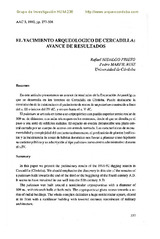Mostrar el registro sencillo del ítem
El yacimiento arqueológico de Cercadilla: avance de resultados
| dc.contributor.author | Marfil Ruiz, Pedro F. | es_ES |
| dc.contributor.author | Hidalgo Prieto, Rafael | es_ES |
| dc.date.accessioned | 2010-02-03T12:56:54Z | |
| dc.date.available | 2010-02-03T12:56:54Z | |
| dc.date.issued | 1992 | |
| dc.identifier.issn | 1130-9741 | |
| dc.identifier.uri | http://hdl.handle.net/10396/2669 | |
| dc.description.abstract | In this paper we present the preliminary results of the 1991-92 digging season in Cercadilla (Córdoba). We should emphasize the discovery in this site of the remains of a palatium built towards the end of the third or the beggining of the fourth century A.D. It seems to have remained in use well into the fifth century A.D. The palatium was built around a semicircular cryptoporticus with a diameter of 109 m., with triconch halls at both ends. The cryptoporticus gives access towards a series of radial buidings. The whole complex delimites a huge semicircular square, closed at its front with a rectilinear building with towered entrance reminiscent of military architecture. The grandiosity of the building scheme, the complexity and secale of this Late Roman monument, the dominance of basilical ground plans, and the absence of domestic quarters, leads us to put forward three main hypotheses: its public character, its relationship with the well-known palatium type, and its function as an administrative and representative complex during the fourth century A.D. | en |
| dc.description.abstract | En este artículo presentamos un avance de resultados de la Excavación Arqueológica que se desarrolla en los terrenos de Cercadilla en Córdoba. Puede destacarse la constatación de la existencia en el yacimiento de restos de un palatium construido a fines del s. III o inicios del IV dC. y en uso hasta el s. V dC. El palatium se articula en torno a un criptopórtico con pasillo superior semicircular de 109 m. de diámetro. con aulas tricontes en los extremos, desde el que se distribuye el paso a una serie de edificios radiales. El espacio en exedra circunscribe una plaza central cerrada por un cuerpo de acceso con entrada torreada. Las características de monumentalidad y complejidad del conjunto tardorromano, el predominio de plantas basilicales y la inexistencia de zonas de hábitat doméstico nos llevan a plantear como hipótesis su carácter público y su adscripción al tipo palatium como centro administrativo durante el s.IV. | es_ES |
| dc.format.mimetype | application/pdf | es_ES |
| dc.language.iso | spa | es_ES |
| dc.publisher | Universidad de Córdoba, Área de Arqueología | es_ES |
| dc.rights | https://creativecommons.org/licenses/by/3.0/ | es_ES |
| dc.source | Anales de Arqueología Cordobesa 3, 277-308 (1992) | es_ES |
| dc.subject | Antigüedades romanas | es_ES |
| dc.subject | Palatium | es_ES |
| dc.subject | Edificios radiales | es_ES |
| dc.subject | Cercadilla (Córdoba, yacimiento) | es_ES |
| dc.subject | Arqueología | es_ES |
| dc.title | El yacimiento arqueológico de Cercadilla: avance de resultados | es_ES |
| dc.type | info:eu-repo/semantics/article | es_ES |
| dc.relation.publisherversion | https://www.uco.es/ucopress/ojs/index.php/anarcor/index | es_ES |
| dc.rights.accessRights | info:eu-repo/semantics/openAccess | es_ES |

